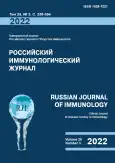Relationships between the indices of innate immunity in sepsis depend on clinical outcomes
- Authors: Savochkina A.Y.1, Poltorak A.E.1, Nikushkina K.V.1, Zotova M.A.1
-
Affiliations:
- South-Ural State Medical University
- Issue: Vol 25, No 3 (2022)
- Pages: 291-294
- Section: SHORT COMMUNICATIONS
- URL: https://journals.rcsi.science/1028-7221/article/view/120197
- DOI: https://doi.org/10.46235/1028-7221-1123-RBT
- ID: 120197
Cite item
Full Text
Abstract
At the present time, sepsis is primarily considered a disorder of the immune system caused by dominant infection, manifesting with individual response reaction of the host organism. Hence, sepsis should not be classified as a distinct pro- or anti-inflammatory syndrome, but rather as a variable continuum of overlapping immune mechanisms. The role of innate immunity in sepsis is probably the leading one, since it exerts an early and nonspecific response to any foreign agent. The nature of appropriate relationships may determine current state of the immune system. To perform a deeper study of the anti-infectious protective mechanisms, we have evaluated the relationships between the immunological parameters of peripheral blood in patients with sepsis, depending on the outcome of the disease. Total number of leukocytes, and neutrophils was determined in whole peripheral blood of the patients with sepsis, along with calculation of leukocyte counts and numbers of neutrophil extracellular traps. Serum levels of procalcitonin, peptidyl-arginine deiminase 4, and cytokines were studied by ELISA assay. To study the relationship between the indices of innate immunity, we used correlation analysis, which was carried out by the Spearman rank criterion. When conducting the statistical analysis, strong correlations between the immunological parameters of peripheral blood in patients with sepsis were not revealed, regardless of the outcome of the disease. In cases of favorable outcome, 10 relationships were identified, with an unfavorable outcome, 7 relationships were registered. All the relationships were of medium strength. Regardless of clinical outcome of sepsis, the significant relationships were established between the number of leukocytes and the level of neutrophil extracellular traps; positive relationships were also found between pro-inflammatory cytokines IL-1 – IL-6, TNF – IL-18. However, these relationships were significant in cases with favorable outcome, while becoming weaker and losing their significance for the group with lethal outcomes.
Among the revealed relationships, the most interesting finding was an association between favorable outcome of sepsis with IL-10 contents, which is an anti-inflammatory cytokine coordinating the innate immune response. In lethal outcomes, such relationship with IL-10 was not revealed. IL-10, a cytokine with anti-inflammatory properties may limit the immune response to pathogens and, thus, potentially prevent damage to the host. Therefore, the relationship between IL-10 and other immunological parameters of peripheral blood in sepsis may affect the outcome of this condition.
Full Text
##article.viewOnOriginalSite##About the authors
A. Yu. Savochkina
South-Ural State Medical University
Email: zotova.chel@mail.ru
PhD, MD (Medicine), Professor, Department of Clinical Laboratory Diagnostics
Russian Federation, ChelyabinskA. E. Poltorak
South-Ural State Medical University
Email: zotova.chel@mail.ru
Senior Laboratory Assistant, Department of Hospital Surgery
Russian Federation, ChelyabinskK. V. Nikushkina
South-Ural State Medical University
Email: zotova.chel@mail.ru
PhD (Medicine), Leading Research Associate, Institute of Immunology
Russian Federation, ChelyabinskM. A. Zotova
South-Ural State Medical University
Author for correspondence.
Email: zotova.chel@mail.ru
PhD (Biology), Senior Research Associate, Institute of Immunology
Russian Federation, ChelyabinskReferences
- Черешнев В.А., Шмагель К.В. Иммунология: учебник. 4-е изд., перераб. и доп. М.: Центр стратегического партнерства, 2014. 520 с. [Сhereshnev V.A., Schmagel K.V. Immunology: textbook. 4th ed., rev. and suppl.]. Moscow: Center for Strategic Partnership, 2014. 520 p.
- Bone R.C. Toward an epidemiology and history of SIRS (systemic inflammatory response syndrome). JAMA, 1992, Vol. 268, no. 24, pp. 3452-3455.
- Ghezzi P., Cerami A. Tumor necrosis factor as a pharmacological target. Methods Mol. Med., 2004, Vol. 98, pp. 1-8.
- Levy M.M., Fink M.P., Marshall J.C., Abraham E., Angus D., Cook D., Cohen J., Opal S.M., Vincent J.-L., Ramsay G. 2001 SCCM/ESICM/ACCP/ATS/SIS International Sepsis Definitions Conference. Crit. Care Med., 2003, Vol. 29, pp. 530-538.
- Papayannopoulos V. Neutrophil extracellular traps in immunity and disease. Nat. Rev. Immunol., 2018, Vol. 18, no. 2, 134-147.
- Saraiva M., O’Garra A. The regulation of IL-10 production by immune cells. Nat. Rev. Immunol., 2010, Vol. 10, no. 3, pp. 170-181.
- Shankar-Hari M., Phillips G.S., Levy M.L., Seymour C.W., Liu V.X., Deutschman C.S., Angus D.C., Rubenfeld G.D., Singer M., Sepsis Definitions Task Force. Developing a new definition and assessing new clinical criteria for septic shock: for the third international consensus definitions for sepsis and septic shock (Sepsis-3). JAMA, 2016, Vol. 315, no. 8, pp. 775-787.
Supplementary files







